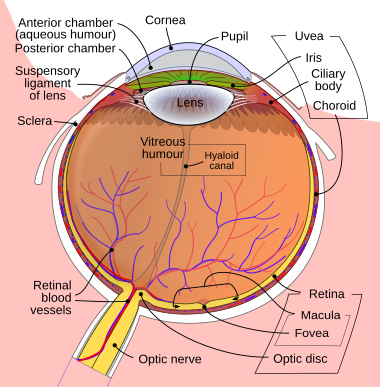| Hyaloid canal | |
|---|---|
 Horizontal section of the eyeball. (Hyaloid canal labeled running through the centre.) | |
| Details | |
| Identifiers | |
| Latin | canalis hyaloideus |
| TA98 | A15.2.06.010 |
| TA2 | 6811 |
| FMA | 58837 |
| Anatomical terminology | |

The hyaloid canal (Cloquet's canal and Stilling's canal [1]) is a small transparent canal running through the vitreous body from the optic nerve disc (at the punctum caecum) to the lens. It is formed by an invagination of the hyaloid membrane, which encloses the vitreous body.
In the fetus, the hyaloid canal contains a prolongation of the central artery of the retina, the hyaloid artery, which supplies blood to the developing lens. Once the lens is fully developed the hyaloid artery retracts and the hyaloid canal contains lymph. The hyaloid canal appears to have no function in the adult eye, though its remnant structure can be seen. [2]
Contrary to initial belief, [3] the hyaloid canal does not facilitate changes in the volume of the lens. The lens volume changes by less than 1% over its range of accommodation. [4] Furthermore, lymph, being liquid, is incompressible, so even if the volume of the lens did change, the hyaloid canal could not compensate for it.
- ^ "hyaloid canal". mondofacto.com. Archived from the original on 3 March 2016. Retrieved 20 December 2010.
- ^ Kagemann, Larry; Wollstein, Gadi; Ishikawa, Hiroshi; Gabriele, Michelle; Srinivasan, Vivek; Wojtkowski, Maciej; Duker, Jay; Fujimoto, James; Schuman, Joel (November 2006). "Persistence of Cloquet's Canal in Normal Healthy Eyes". Am J Ophthalmol. 142 (5): 862–864. doi: 10.1016/j.ajo.2006.05.059. PMC 1939820. PMID 17056372.
- ^ T. P. Anderson Stuart (29 March 1904). "The function of the hyaloid canal and some other new points in the mechanism of the accommodation of the eye for distance". The Journal of Physiology. 31 (1): 38–48. doi: 10.1113/jphysiol.1904.sp001021. ISSN 0022-3751. PMC 1465472. PMID 16992721.
- ^ Marussich, Lauren (2015). "Measurement of Crystalline Lens Volume During Accommodation in a Lens Stretcher". Investigative Ophthalmology & Visual Science. 58 (8): 4239–4248. doi: 10.1167/iovs.15-17050. PMC 4502455. PMID 26161985.
| Hyaloid canal | |
|---|---|
 Horizontal section of the eyeball. (Hyaloid canal labeled running through the centre.) | |
| Details | |
| Identifiers | |
| Latin | canalis hyaloideus |
| TA98 | A15.2.06.010 |
| TA2 | 6811 |
| FMA | 58837 |
| Anatomical terminology | |

The hyaloid canal (Cloquet's canal and Stilling's canal [1]) is a small transparent canal running through the vitreous body from the optic nerve disc (at the punctum caecum) to the lens. It is formed by an invagination of the hyaloid membrane, which encloses the vitreous body.
In the fetus, the hyaloid canal contains a prolongation of the central artery of the retina, the hyaloid artery, which supplies blood to the developing lens. Once the lens is fully developed the hyaloid artery retracts and the hyaloid canal contains lymph. The hyaloid canal appears to have no function in the adult eye, though its remnant structure can be seen. [2]
Contrary to initial belief, [3] the hyaloid canal does not facilitate changes in the volume of the lens. The lens volume changes by less than 1% over its range of accommodation. [4] Furthermore, lymph, being liquid, is incompressible, so even if the volume of the lens did change, the hyaloid canal could not compensate for it.
- ^ "hyaloid canal". mondofacto.com. Archived from the original on 3 March 2016. Retrieved 20 December 2010.
- ^ Kagemann, Larry; Wollstein, Gadi; Ishikawa, Hiroshi; Gabriele, Michelle; Srinivasan, Vivek; Wojtkowski, Maciej; Duker, Jay; Fujimoto, James; Schuman, Joel (November 2006). "Persistence of Cloquet's Canal in Normal Healthy Eyes". Am J Ophthalmol. 142 (5): 862–864. doi: 10.1016/j.ajo.2006.05.059. PMC 1939820. PMID 17056372.
- ^ T. P. Anderson Stuart (29 March 1904). "The function of the hyaloid canal and some other new points in the mechanism of the accommodation of the eye for distance". The Journal of Physiology. 31 (1): 38–48. doi: 10.1113/jphysiol.1904.sp001021. ISSN 0022-3751. PMC 1465472. PMID 16992721.
- ^ Marussich, Lauren (2015). "Measurement of Crystalline Lens Volume During Accommodation in a Lens Stretcher". Investigative Ophthalmology & Visual Science. 58 (8): 4239–4248. doi: 10.1167/iovs.15-17050. PMC 4502455. PMID 26161985.